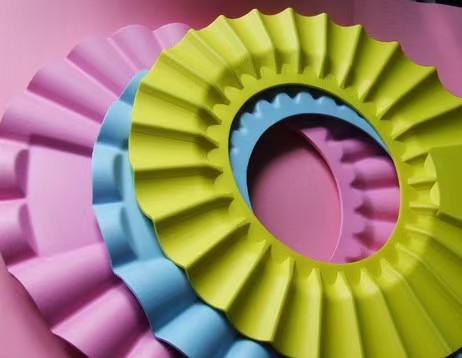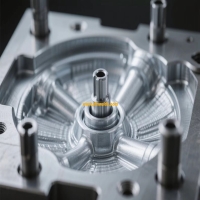ข้อบกพร่องทั่วไปของผลิตภัณฑ์หล่อขึ้นรูปและการแก้ปัญหาของพวกเขา
ข้อบกพร่องทั่วไปของผลิตภัณฑ์หล่อขึ้นรูปและการแก้ปัญหาของพวกเขา
การวินิจฉัยและสาเหตุของข้อบกพร่องของผลิตภัณฑ์ทั่วไปมีดังนี้
(1) การเยื้องผลิตภัณฑ์
ปรากฏการณ์: การซึมเศร้าหรือฟองสบู่, บ่อยุบ, การหดตัว, ฟันผุหดตัว, ฟองสุญญากาศ ฯลฯ ในผลิตภัณฑ์ล้วนเป็นข้อบกพร่องของผลิตภัณฑ์
เหตุผลก็คือเนื่องจากการยึดและการให้อาหารที่ไม่ดีผลิตภัณฑ์จะเย็นลงอย่างไม่สม่ำเสมอและสารประกอบยางในโพรงเชื้อราไม่เพียงพอทำให้เกิดการหดตัวของพลาสติกมากเกินไป สิ่งนี้ส่งผลให้รอยบุบล่มสลายฟองสุญญากาศและเงากลวงบนพื้นผิวผลิตภัณฑ์ทำให้มีลักษณะที่ไม่สม่ำเสมอ
(2) ผลิตภัณฑ์สำเร็จรูปไม่เป็นที่น่าพอใจ
ปรากฏการณ์: ชิ้นส่วนพลาสติกที่ไม่ดีแม่พิมพ์ที่ไม่สมบูรณ์และพื้นผิวฟองที่ไม่สมบูรณ์เป็นข้อบกพร่องทั้งหมดของผลิตภัณฑ์สำเร็จรูปที่ไม่สมบูรณ์
เหตุผลหลักคือการไหลของวัสดุที่ไม่ดีการให้อาหารไม่เพียงพอการไหลของการเติมวัสดุหลอมเหลวไม่ดีอัตราเงินเฟ้อที่มากเกินไปและไอเสียที่ไม่ดีซึ่งทำให้การเติมโพรงเชื้อราไม่สมบูรณ์ส่งผลให้รูปร่างพลาสติกที่ไม่สมบูรณ์และไม่สมบูรณ์
(3) แฟลชผลิตภัณฑ์
ปรากฏการณ์: แฟลชที่มากเกินไปและขอบขรุขระส่วนใหญ่เป็นข้อบกพร่องของเสี้ยนของผลิตภัณฑ์
เหตุผลก็คือเนื่องจากการยึดแม่พิมพ์ที่ไม่ดีการอุดตันหรือช่องว่างที่มากเกินไปที่ขอบแม่พิมพ์ความลื่นไหลของพลาสติกที่ดีเกินไปและการฉีดสารประกอบยางมากเกินไปผลิตภัณฑ์ชิ้นส่วนพลาสติกมีปีกบาง ๆ ขอบขุย ฯลฯ ตามขอบ
Car Mould_Taizhou jiefeng Mold Co.,Ltd. (jfmoulds.com)
(4) การเชื่อมผลิตภัณฑ์ไม่ดี
ปรากฏการณ์: รอยเชื่อมที่ชัดเจนและเส้นฟิวชั่นพื้นผิวเป็นข้อบกพร่องทั้งหมดของการเชื่อมที่ไม่ดีในผลิตภัณฑ์
เหตุผลก็คือเนื่องจากการปนเปื้อนของวัสดุการระบายความร้อนมากเกินไปของสารประกอบยางและการใช้สารปลดปล่อยเชื้อรามากเกินไปปริมาณความชื้นของวัสดุที่หลอมเหลวและวัสดุผสมจะลดลงและเรซินและสิ่งที่แนบมานั้นไม่สามารถเข้าใจได้ เหตุผลเหล่านี้นำไปสู่การหลอมรวมที่ไม่ดีในระหว่างการหลอมเหลวและการไหลของวัสดุผสมส่งผลให้ตะเข็บดีหรือเส้นฟิวชั่นที่อ่อนแออย่างเห็นได้ชัดตามพื้นผิวหรือด้านในของผลิตภัณฑ์
(5) รอยแตกในผลิตภัณฑ์
ปรากฏการณ์เช่นการดึงรอยแตกรอยร้าวด้านบนการแตกและการแตกของเปลือกเต่าเป็นข้อบกพร่องทั้งหมดของรอยแตกของผลิตภัณฑ์
เหตุผล: เนื่องจากความเครียดภายในที่มากเกินไปของผลิตภัณฑ์การ demolding ที่ไม่ดีการระบายความร้อนที่ไม่สม่ำเสมออัตราส่วนการผสมพลาสติกที่ไม่เหมาะสมประสิทธิภาพที่ไม่ดีและการออกแบบแม่พิมพ์ที่ไม่ดี

(6) การเสียรูปของผลิตภัณฑ์
ปรากฏการณ์เช่นการเสียรูปการแปรปรวนการบวมของพื้นผิวและความไม่แน่นอนของมิติล้วนเป็นข้อบกพร่องของการเสียรูปของผลิตภัณฑ์
เหตุผลอันเนื่องมาจากความเครียดภายในที่เกิดจากความเครียดที่เหลือ, ความเครียดแรงเฉือน, ความหนาของผนังที่ไม่สม่ำเสมอของผลิตภัณฑ์และการหดตัวที่ไม่สม่ำเสมอในระหว่างการฉีดขึ้นรูปพร้อมกับการทำลายล้างที่ไม่ดีการระบายความร้อนไม่เพียงพอความแข็งแรงของผลิตภัณฑ์ไม่เพียงพอการเปลี่ยนรูปของเชื้อราและเหตุผลอื่น ๆ ของเครื่องฉีดขึ้นรูปและเงื่อนไขทางเทคนิคของกระบวนการที่ไม่เสถียรการเปลี่ยนแปลงมิติของผลิตภัณฑ์ไม่เสถียร
สินค้า Mould_Taizhou jiefeng Mold Co.,Ltd. (jfmoulds.com)
(7) รูปแบบเงินบนผลิตภัณฑ์
ปรากฏการณ์: รูปแบบด้ายสีเงิน, รูปแบบเมฆพื้นผิว, รูปแบบสีเงินพื้นผิว ฯลฯ ล้วนเป็นข้อบกพร่องของรูปแบบเงินในผลิตภัณฑ์
เหตุผลก็คือเนื่องจากความชื้นมากเกินไปการเติมอากาศมากเกินไปหรือสารระเหยมากเกินไปในวัตถุดิบพลาสติกวัสดุหลอมเหลวจะถูกตัดมากเกินไปพื้นผิวของแม่พิมพ์ที่หลอมเหลวนั้นปิดผนึกไม่ดี
(8) การเปลี่ยนสีของผลิตภัณฑ์
ปรากฏการณ์: ความแตกต่างของสีสีที่ไม่สม่ำเสมอและการเปลี่ยนสีของผลิตภัณฑ์เป็นข้อบกพร่องทั้งหมดของการเปลี่ยนสีของผลิตภัณฑ์
Reason Due to poor distribution of pigments or fillers, material contamination and degradation, excessive volatile substances in materials, and decomposition of colorants and additives, plastics or pigments may change color, resulting in color differences on the surface of the products. Products with uneven color are often related to the poor thermal stability of plastics and raw materials. Uneven color in the welded part is often related to the deterioration and degradation of pigments (uneven color refers to the phenomenon where the color of the product is either darker or lighter and inconsistent with the standard color after comparison).
(9) Product corrugations
Phenomena: Surface ripples, flow patterns, plastic surface ripples, etc. are all ripple defects of the products.
The reason is that the molten material does not flow smoothly along the mold surface to fill the cavity, but rather flows in a semi-cured and fluctuating state along the mold cavity surface. There is a retention phenomenon of the molten material, causing ripples.
(10) The product is rough
Phenomena: Dull surface, rough surface, mold spots, streaks, scratches, mold marks, handprints, etc. are all manifestations of rough or unsmooth products.
The main reasons are insufficient surface finish of the mold, poor adhesion between the molten material and the mold surface, other impurities adhering to the mold or surface marks after mold maintenance and repair, improper operation, lack of cleanliness, and improper setting of parameters such as material temperature and mold temperature, which result in the product surface being not bright, having marks, not smooth, scratches and scars, mold marks, and the surface being milky white or whitish.
(11) Bubbles in the product
Phenomenon: Defects such as internal vacuum bubbles in the product or bubbles in expanded products.
The reason is that due to excessive inflation or poor venting in the molten material, the remaining monomers, gases and moisture inside the product form small or string cavities or vacuum bubbles.
(12) The product sticks to the mold
Phenomena: Poor demolding, plastic part sticking to the mold and other defects.
The reason is that due to material contamination or non-drying, poor demolding performance of the mold, overly strong filling effect, etc., the products are difficult to demold or deform or crack after demolding, or the residual direction of the products does not meet the design requirements.
(13) The products delaminate and peel off
Phenomena: Defects such as delamination and peeling of mica flakes, and layered plastic at the gate.
The reason is that due to improper raw material mixing ratio, improper material temperature or mold temperature, uneven plasticization, and excessive shear force when the molten material flows along the mold surface, the material peels off in thin layers, resulting in a decline in the physical properties of the product.
(14) Gate sticking to the mold
Phenomena: Gate or sprue blockage, broken glue, broken pins, runner sticking to the mold, and sprue sticking to the mold are all gate sticking defects. In mild cases, the mold sticks; in severe cases, it gets clogged.
The reason is that due to insufficient design of the gate opening and the slope of the gate, the limited force acting inside the gate sleeve, or insufficient cooling, the gate adheres to the gate sleeve or blocks the sprue, etc.
(15) The product is cloudy
Phenomenon: Poor transparency, turbidity defect at the gate of the product.
The reasons are as follows: Due to material contamination and poor drying, poor contact between the molten material and the mold surface, fine depressions on the product surface causing random light scattering or plastic decomposition, and the presence of impurities and waste materials, the mold surface is not bright, and the exhaust is not good, which can cause the transparent plastic to be poorly transparent or uneven.
(16) Spots on the product
Phenomenon: Black spots, black lines, yellow spots, yellow lines, black stripes, brown stripes, etc. on the product are all spot defects of the product.
Reason: Due to the decomposition of plastic or the decomposition and combustion of flammable volatile substances, air, etc. in the material under high temperature and high pressure, the burned resin is injected into the mold cavity along with the molten material, presenting various spots on the surface of the product, such as black spots, yellow spots, black stripes, brown stripes, etc., or along the surface of the product, it shows a grayish burn.
(17) Stiff lumps of the product
Phenomenon: Defects such as cold lumps or hard lumps in the product.
The reason is that due to the addition of cold materials or poorly plasticized rubber compounds, these unplasticized and insufficiently plasticized materials cause the plastic products to be undercooked.
(18) Glue leakage
Phenomena: Defects such as material overflow and glue dripping from the nozzle.
The reasons are: The temperature setting of the barrel and the nozzle is improper, the contact between the nozzle and the main gate die is poor, the clamping force is uneven or unstable, the fluidity of the plastic is too good, and the temperature of the nozzle is too high, resulting in the phenomenon of glue leakage and material overflow.
Defects in injection molding products are the root cause of substandard product quality, and these defects are also related to the technical proficiency of injection molding operators and maintenance workers. To ensure product quality, injection molding operators are required to have rich practical experience in injection molding machines and process technologies. One should be familiar with and understand the performance of the injection machine being used, and have a comprehensive grasp and application of it. It is necessary to have a comprehensive grasp of injection molding process technology and master the entire process setting and calibration from plastic raw materials to product packaging.
During the injection molding operation process, common product defects also have certain trends. The common practice is to accurately identify and diagnose product defects, comprehensively analyze the possible causes, and combine practical work experience to explore a set of rules. Through the setting of plastic raw materials, various temperature parameters, pressure parameters, speed parameters, stroke parameters, and time parameters, In light of specific circumstances such as molds, nozzles, melt tubes, screws, as well as lubricants and mold release agents, reasonable parameter presetting and modification should be carried out. The process technical parameters should be adjusted and corrected in combination with the actual situation. Through calibration and trial operation, product defects can be prevented and product quality can be guaranteed to be qualified.
การแปรรูป equipment_Taizhou บริษัท jiefeng Mold Co.,Ltd. (jfmoulds.com)
ข้อมูลที่เกี่ยวข้อง
เทคโนโลยีประตูแม่พิมพ์ฉีด
2025-07-23
Injection Mold Gate TechnologyGating Systemauto Mould_taizhou Jiefeng Mold Co., ...
กุญแจสำคัญในการปั้นผลิตภัณฑ์พลาสติก
2025-07-21
กุญแจสำคัญในการขึ้นรูปผลิตภัณฑ์พลาสติกที่อยู่อาศัยอยู่ในโลกแห่งพลาสติก Prottain Produ
สำรวจวงจรชีวิตเต็มรูปแบบของแม่พิมพ์ฉีดและความคิดเกี่ยวกับความก้าวหน้าของอุตสาหกรรม
2025-07-15
สำรวจวงจรชีวิตเต็มรูปแบบของแม่พิมพ์ฉีดและความคิดเกี่ยวกับ breakt อุตสาหกรรม...
ส่วนมาตรฐานของแม่พิมพ์
2025-07-24
ชิ้นส่วนมาตรฐานของ Molds1 Mold FramePrefabricated Assemblies ฐานแม่พิมพ์มาตรฐาน o ...
ลักษณะการทำงานและเกณฑ์การเลือกของแม่พิมพ์ฉีด
2025-06-30
ลักษณะการทำงานและเกณฑ์การเลือกของแม่พิมพ์ฉีดนี้...
แม่พิมพ์ฉีด: "ยีนอุตสาหกรรม" ซ่อนอยู่หลังทุกอย่าง
2025-07-12
แม่พิมพ์ฉีด: "ยีนอุตสาหกรรม" ซ่อนอยู่เบื้องหลังทุกอย่างเมื่อ Fing ของเรา...





